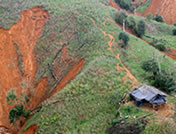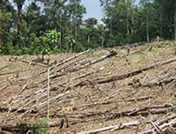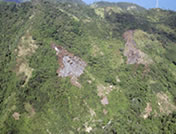Colombia: Counting the cost of cocaine
16.04.10
From ancient medicines, religious rituals, to famous soft drinks, and being sniffed off toilet-seats in high society clubs, very few plants have had such an effect on people and the environment as Erythroxylum coca (coca).
It's no secret that Colombia is infamous for its cocaine production, but less well known is the environmental toll this is taking on some of the world's most pristine landscapes and the social cost of producing this most fashionable of drugs.



Some images of the environmental devastation being led by coca production in Colombia.
© Shared Responsibility
But a new initiative, launched by the Colombian government in London a couple of weeks ago, aims to remove the national blame culture that has always infected issues of international drug control and replace it with a common purpose.
The launch of Shared Responsibility is timely and their mission statement simple and unequivocal: "Shared Responsibility operates under the simple but steadfast belief that if cocaine consumers were made aware of the atrocious ways in which their drug money is put to use in Colombia, they would not only rethink their cocaine habit but actively support the eradication of coca crops from Colombia."
Just a week ago we heard news that British lawyer Polly Higgins had embarked on a campaign to pressure the UN into accepting ecocide as a fifth "crime against peace", which could be tried at the International Criminal Court. Taken individually each element of cocaine production could, arguably, be counted as ecocide, but cumulatively the cost is truly monumental.
Coca, like many cash crops, displaces habitat. The prime real estate for coca just happen to be some of the most biodiverse forest systems we know of.
-
"2.2 million hectares of tropical forest, an area equal to the size of Slovenia, has been clear cut to grow coca in Colombia" (Source: Colombian Drugs Observatory)
Even protected areas are susceptible to the insurgence but as these areas, and the drug trade itself, are controlled by paramilitary forces there is little effective policing.
-
"In 2006, over 8,000 hectares of Colombia’s national parks were clear cut to grow coca". (Source: Colombian Anti-Narcotics Police)
It is in the farmers' best interests to keep their production out of sight. This means encroaching into more and more remote areas. Almost by default the more remote the land is, the more it, and its inhabitants, can potentially suffer from coca production.
-
"To prevent detection, illicit crops often shift, generally within hard-to-reach areas, causing damage to virgin forests. And, many of these crops are found in places with very high levels of biodiversity". (Source: Colombian Anti-Narcotics police)
The harvested coca is processed in "labs" in the forest. The process is disgusting and polluting (the chemicals involved are nicknamed the dirty dozen), but the chemical pollution doesn't end there. To combat the growers the US government sprays vast expanses of the forest with glyphosate. Undoubtedly, this impacts the coca crop, but being non-specific kills vast amounts of forest life with it and only serves to drive the production ever deeper into the forest. Agent Orange all over again...
-
"To obtain one kilo of coca paste (stage prior to the processing of cocaine) 1.9 litres of sulphuric acid, 1.25 litres of ammonium, 193.75 litres of contaminated water and 625 kilograms of vegetable waste are thrown onto the ground or into nearby rivers". (Source: Colombian Drugs Observatory)
Spain and UK, apparently, consume more drugs than any other nation in the EU, while the US remains the main recipient of Colombian cocaine.
-
"One hectare of coca produces and average 7.4 kilos, or 7,700 grams, of cocaine per year, one gram being the measure of a dose. Therefore, for each 7,400 doses of cocaine, up to 3 hectares of 30 thousand square meters of forest are cut down. In other words, for each gram of cocaine consumed, 2 square metres of tropical forest are clear cut". (Source: UNODC; SR Calculation)
Cocaine farmers are just like any other farmers they want to maximise their yields.
-
"Global coca cultivation decreased by 29% from 2000-2006 while production levels of cocaine remained stable. This is due to improved yields and better coca growing practices." (Source: UNODC 2007 World Drugs Report)
The scale of the problem is staggering, and the numbers daunting, but programmes like Shared Responsibility may help shine a light on the issues and instigate increased global awareness and practical action. But while tackling deforestation for legal ends - palm oil, cattle ranching, soy - remains such a challenge the road is likely to be a long one.
Plant Talk will be covering this story in more depth in the coming weeks, so keep reading.
Related articles:
Philippines: Geo-tagging reveals mining threats on the “Last frontier”
01.02.10
 Plant Talk invited Dario Novellino from the Centre for Biocultural Diversity (CBCD), UK to speak out against the logging and mining in protected areas that is destroying the forests of Palawan.
Plant Talk invited Dario Novellino from the Centre for Biocultural Diversity (CBCD), UK to speak out against the logging and mining in protected areas that is destroying the forests of Palawan.
Ecuador: Yasuni - the most biodiverse place on Earth?
22.01.10
A study published in the open access journal Plos One has revealed extraordinary species richness in the western Amazon covering eastern Ecuador and northern Peru.